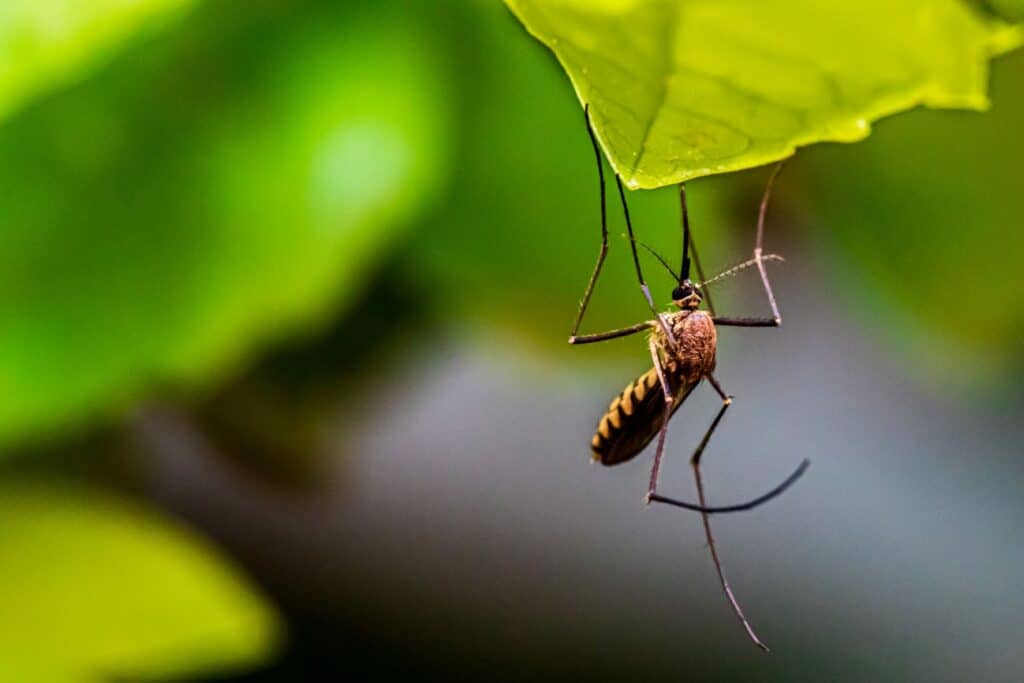In many parts of the U.S, mosquito and tick season are in full swing! While keeping your yard tidy, eliminating standing water, wearing protective clothing and planting certain pest repelling plants may help, there will likely be times that you need safe and effective insect repellants.

This post contains affiliate links. I may earn a small commission on qualifying purchases.
The Environmental Working Group (EWG) offers a list of low toxicity, effective insect repellant active ingredients that we are going to explore in this post.
- DEET (at less than 30 percent)
- Picaridin
- Oil of Lemon Eucalyptus and its synthetic derivative PMD
- IR3535 (at 20 percent)
- 2-Undecanone
They make this statement regarding other botanical insect repellants, which includes most essential oil blends: “While products based on botanical extracts do not make our top picks, they may be worth trying if bug-borne diseases are not a big problem where you are located or traveling to.”
Essential oil repellants are considered minimal risk, which means they are not required to be registered with the EPA or undergo their efficacy testing.
The data available suggests they are less effective than EPA-registered repellants mostly because they do not work for very long periods of time. Once the smell dissipates, so does their effectiveness.
Is DEET a Safe Insect Repellant
Let’s start with DEET, which is what you will find in many popular Off and Cutter bug repellants. It is the most widely used insect repellent in the U.S. DEET has been around longer than any other active ingredient, and many scientists consider it the gold standard.
What Exactly Is Deet? DEET (official name N, N-Diethyl-meta-toluamide) is a yellowish liquid that repels a number of insects, including mosquitoes, ticks, and fleas. You can apply it to skin or clothing—it is very effective. USDA chemists created the compound in the 1940s for use by the U.S. military and became available for public use in the 1950s.
Deet repels insects but does not kill them. Some experts believe that DEET blocks an insect’s ability to smell human sweat and breath. while others believe the stench of the compound is so offensive to bugs that they just flee the scene.
How Did DEET Get a Bad Wrap?
14 cases of potential brain damage were reported in the medical literature between the early 1980s and late 1990s. All but one of these instances were in children younger than 8. Three of those children died, and Deet was believed to be the culprit, but this was not 100% confirmed.
Over the years, there have been more reports of poisoning, but most have been mild. Instances often involved overuse or misuse of products (including ingestion). A 2009 study concluded that DEET may prevent the normal breakdown of acetylcholine, a nervous system chemical that controls regulating nerve impulses. These findings are disputed by some experts, and in 2014 the EPA did a full safety review.
Countries vary on what concentrations they allow and consider safe. While U.S. DEET products range from 5%-99%, the EU does not allow anything over 50% to be sold, and their Centre for Disease Prevention and Control does not recommend the use DEET products at concentrations over 20% for any age.
Health Canada recommends DEET with concentrations no greater than 10 percent for children.
Precautions for DEET
Despite the bad wrap, many experts consider DEET safe when used per label. The APP, CDC and the EWG recommend quite a few precautions, especially when using DEET on children. We’ll go over those:
- Do not use DEET on children under 2 months old.
- Young children should not apply the repellent themselves. Do not apply it near a child’s mouth or eyes or on their hands.
- Do not apply products containing DEET to any type of broken skin (cut, wound, etc.).
- Avoid aerosol sprays or spray hands then apply to the body to avoid inhalation.
- Pediatricians recommend not using DEET on a child more than once a day and showering and washing clothes to remove the repellant after use,
- Always use the lowest potency needed. The higher percentage means the product works longer, not better. For example, a 10% concentration works for up to 2 hours. Products with a 20-30% concentrations will last up to 5 hours. The APP does not recommend a concentration over 30% for children. Keep in mind Canada and Europe have stricter recommendations.
- Avoid products containing sunscreen and DEET (or other repellants) as those need repeated applications, which will lead to over exposure.
- Be cautious if pregnant. Some DEET will absorb into the skin and cross the placenta. Safety data during pregnancy is favorable but limited for the first trimester.

DEET is toxic at extremely high levels to fish and insects but not to birds. According to the CDC, DEET breaks down by sunlight and other chemicals in the air quickly.
Half of the DEET released into the atmosphere disappears within 5 hours. DEET is breaks down in water by microorganism within a few weeks. It does not linger in the environment for especially long periods of time.
The EWG offers these approved DEET options: Coleman, Cutter, OFF! Active (Family Care and Deep Woods too) and Repel Sawyer.
Picaridin
Picaridin is another common highly effective synthetic insect repellant. It’s the active ingredient in popular bug sprays like OFF and Avon Skin-So-Soft Bug Guard Plus Picaridin. It keeps bugs at a distance whereas when using DEET bugs will still land on you just not bite.
Picaridin hit the market in 2005, so it is considerably newer than DEET, and we have less research on it. The repellent mimics a molecule found in pepper plants. One big difference between picaridin and DEET is that picaridin is odorless, while DEET has a strong smell that some people cannot tolerate.
Spray products with at least 20 percent picaridin test as well and, in some cases, better than DEET products. Repellant time ranges from 4-8 hours. While we have less research on picaridin, most experts believe the chemical is safe.
A small amount of picaridin is absorbed through the skin but should exit the body within 24 hours. Based on mice studies, experts do not believe it increases a person’s cancer risk. Picaridin is moderately toxic to fish and other water ecosystems but not thought to harm birds.
Some EWG Approved Picaridin Containing Options are: Natrapel 8-hour, OFF! Family Care (Clean Feel versions) and Sawyer Picaridin.
Is Oil of Lemon Eucalyptus an Effective Insect Repellant?
If you are like me and tend to favor things created by nature, especially when they can do the job as well as synthetic products, then you may want to consider products with the active ingredient oil of eucalyptus (OLE).
When you use OLE at a concentration of 30%, it is a highly effective insect repellant for approximately 2 hours. OLE is registered with the EPA as a biopesticide, so products containing this active ingredient are tested for safety and efficacy. The requirements, however, for biopesticides are laxer than they are for synthetics like DEET and picaridin.
Experts do not recommend OLE for children under age 3. Otherwise, the EPA and CDC recommend it as an effective and safe option for repelling insects. OLE products often contain PMD concentration to make them more effective. PMD is a processed and enhanced form of OLE.
There are several EWG-Approved Oil of Lemon Eucalyptus options: Coleman Botanicals, Cutter Lemon Eucalyptus, OFF! Botanicals and Repel Plant-Based Lemon Eucalyptus.
IR3535
IR3535 or Ethyl butylacetylaminopropionate is new to me. It came into existence in the mid 70s and is quite popular in Europe. The odorless molecule was approved for use in the U.S. in 1999. A 20% concentration provides 8 hours of mosquito protection and 6-12 hours of tick protection. It is more effective against deer ticks than DEET.
The EPA and EWG consider it a good DEET alternative. Europe, where it is more popular, has not experienced any reports of harm from the product. Safety tests on animals are favorable, and issues are only present when the compound is given at toxic levels. IR3535 is somewhat biodegradable and does not seem to be an environmental threat.
This ingredient is often part of a sunscreen combo. As with DEET, you want to avoid these as reapplications would cause a person to overuse the repellant. Since IR3535 is not extremely popular in the U.S., the only EWG Approved option listed is Coleman Skin Smart.
2-Undecanone
2-Undecanone (official name methyl nonyl ketone) is an EPA-registered repellent that can be found naturally in clove, strawberry and tomato plants. The ingredient showed no toxicity via oral and inhalation routes in laboratory studies, but it can cause slight skin and eye irritations as do most other repellants.
The only EPA-approved repellant that uses 2-undecanone is Bite Blocker BioUD, which is a little hard to find. One application provides five hours of mosquito repellence and two hours of tick protection. There are only a few studies comparing the efficacy of 2-undecanone with other repellents, but it tested as well as DEET in some cases.
Popular Essential Oil Repellents

As mentioned earlier, the EPA considers most botanical insect repellants (essential oil blends) low risk, so they are not subject to EPA registration and testing. Common essential oil repellants contain castor oil, cedar oil, citronella oil, clove oil, geraniol oil, lemongrass oil, peppermint oil, rosemary oil and/or soybean oil.
These repellants tend not to repel as long, while results vary from product to product. The EWG recommends botanical repellents only if you are in an area of low risk. You can check with the manufacturer to see what proof of efficacy they have to offer.
Since some essential oil repellants contain allergens at high concentrations, the EWG recommends a small patch test before full application. Badger Anti-bug Shake and Spray and Anti-bug Balm Stick are two high-quality choices in this category.
Both products have favorable reviews on multiple websites. Several reviewers mention the need for frequent reapplication. The U.S. made repellant is USDA organic and uses pure lemongrass, citronella, cedar and rosemary essential oils.
Labratory tests confirm they repel mosquitos, but they may not offer much tick protection. If you live in a relatively low-risk area where Lyme Disease is not a major concern or you don’t plan to be outside very long, Badger may be worth a try.
West Nile and Lyme Disease
It is helpful to know which pests frequent the area that you live in or your favorite vacation spots. This can help you figure out how much protection you need and when you need it.
For example, Lyme disease cases concentrate in 14 Northeastern and Mid-Atlantic states as well as the upper Midwest. Maine and Vermont had the highest number cases in 2019, which is the last year of data available online. You are most likely to contract Lyme disease between late April and August. Check out the CDC Lyme Disease data table for more details.
West Nile cases occur in almost every state, with the most cases reported in Texas and California for the year 2020 (no data available for 2021). According to the CDC, infections from mosquitoes carrying West Nile virus occur primarily in the summer months, peaking in August. You can check out this CDC West Nile chart for more information on U.S. cases.
Simple Tips to Deter Insects
- Avoid wearing bright colors.
- Do not use scented soaps, perfumes or hair products.
- Cover up with pants, socks and long sleeves as needed
- Avoid areas with high grass or standing water.
- Use screened areas and fans for outdoor dining.

Tick Checks
Prompt tick removal goes a long way to reduce likeliness of infection. Ticks tend to love cracks and cervices but unfortunately can attach anywhere on the body. We try to do a tick check anytime the kids have been out playing in the yard during the spring, summer and early fall. If your kids are young, you can also teach them to check each other at bath time.
We keep tick keys on hand for safe removal if anyone does get a tick. Tick keys will remove a tick the right way and not leave the head lodged (sorry, gross!). These are for pets and people, and they are easy to use. Experts suggest not to apply alcohol, which many of us did growing up. Skip the tweezers too, as they can burst the tick and increase infection risk (sorry, double gross!).
If you do remove a tick, you can freeze it in case someone develops symptoms then send it off for testing. Talk to your doctor about how the testing process works.
Takeaways
Some key takeaways are to always follow the label recommendations (only apply DEET and Picardian products to children once per day), use the lowest effective concentrations of the active ingredient you choose and know the risks in your area and choose a product accordingly.
As always, I learned some new things while researching for this post and hope you did too! I plan to hang on to my light-duty botanical/essential oil blends for the day to day, but I am glad to have information on some safe longer-lasting options if we go hiking, camping or do any outdoor summer camps.
Personally, I am most comfortable with the OLE and 2-Undecanone options followed pretty closely by IR3535 and Picardian as I appreciate the always-cautious EU safety standards. I personally don’t see a need for DEET for my family at this time (bad reputations die hard, I suppose), but I am slightly more comfortable with it after my research.
I hope you learned something new about safe and effective insect repellants. Be sure to check out my related post, Safe and Natural Pest Management.
Great information!